1998 CHEVROLET VENTURE radiator
[x] Cancel search: radiatorPage 356 of 474
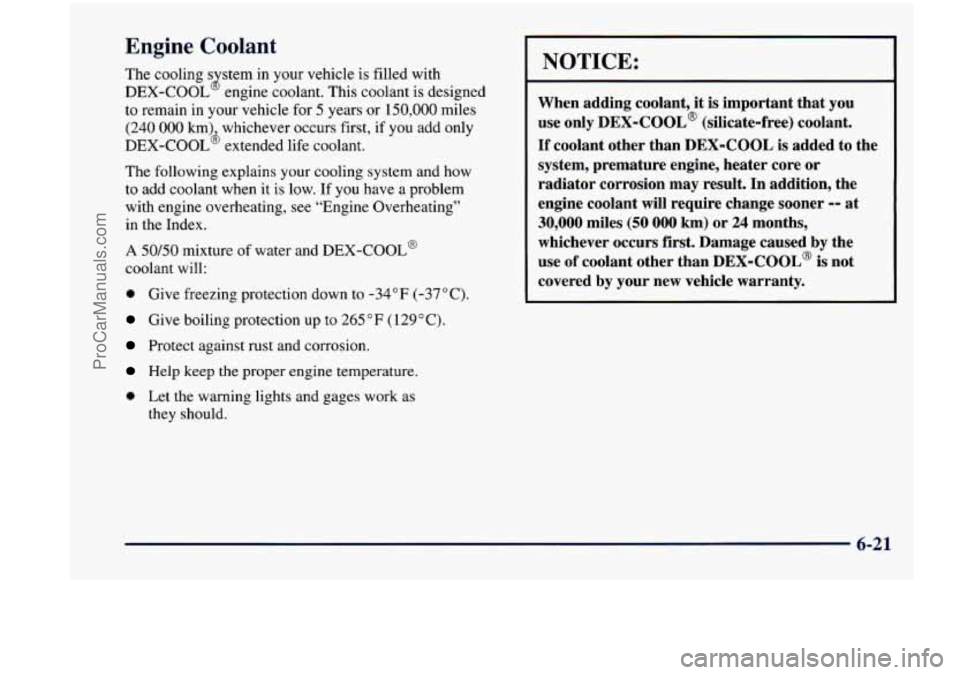
Engine Coolant
The cooling s stem in your vehicle is filled with
DEX-COOL engine coolant. This coolant is designed
to remain
in your vehicle for 5 years or 150,000 miles
(240 000 km) whichever occurs first, if you add only
DEX-COOLd extended life coolant.
J
The following explains your cooling system and how
to add coolant
when it is low. If you have a problem
with engine overheating, see “Engine Overheating”
in the Index.
A 50/50 mixture of water and DEX-COOL@
coolant will:
0 Give freezing protection down to -34°F (-37°C).
Give boiling protection up to 265 OF ( 129 O C).
Protect against rust and corrosion.
Help keep the proper engine temperature.
0 Let the warning lights and gages work as
they should.
~
~
NOTICE:
When adding coolant, it is important that you
use
only DEX-COOL@ (silicate-free) coolant.
If coolant other than DEX-COOL is added to the
system, premature engine, heater core or
radiator corrosion may result. In addition, the
engine coolant will require change sooner
-- at
30,000 miles (50 000 km) or 24 months,
whichever occurs
first. Damage caused by the
use
of coolant other than DEX-COOL@ is not
covered by your new vehicle warranty.
6-21
ProCarManuals.com
Page 357 of 474
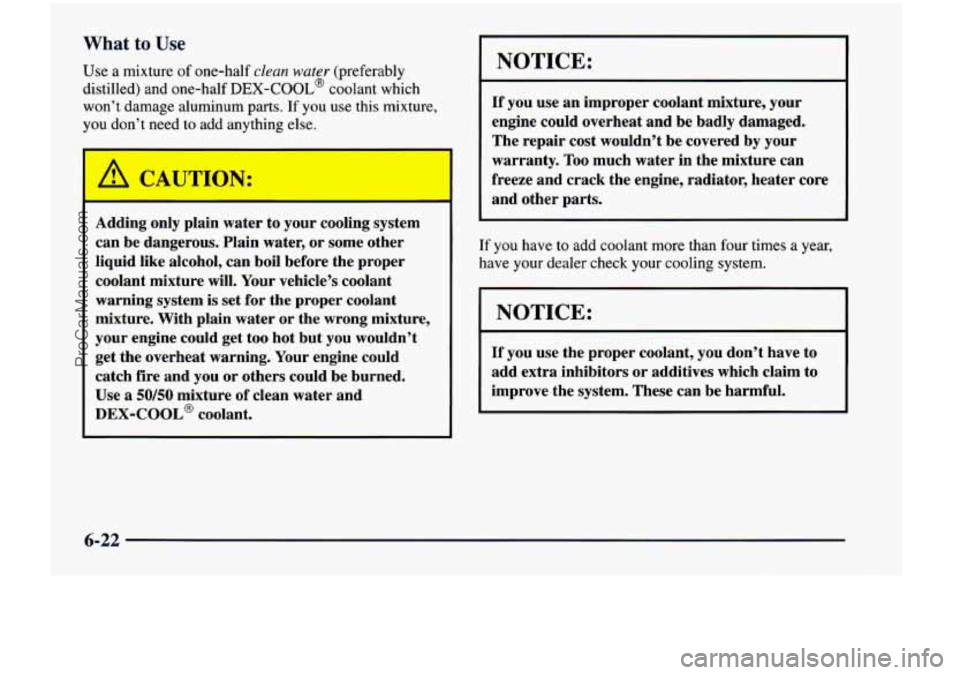
What to Use
Use a mixture of one-half clean water (preferably
distilled) and one-half
DEX-COOL@ coolant which
won’t damage aluminum
parts. If you use this mixture,
you don’t need to add anything else.
I
I
Adding only plain water to your cooling system
can be dangerous. Plain water, or some other
liquid like alcohol, can boil before the proper
coolant mixture will. Your vehicle’s coolant
warning system is set for
the proper coolant
mixture. With plain water or the wrong mixture,
your engine could get too hot but you wouldn’t
get the overheat warning. Your engine could
catch fire and you or others could be burned.
Use
a 50/50 mixture of clean water and
DEX-COOL@ coolant.
NOTICE:
If you use an improper coolant mixture, your
engine could overheat and be badly damaged.
The repair cost wouldn’t be covered by your
warranty.
Too much water in the mixture can
freeze and crack the engine, radiator, heater
core
and other parts.
If you have to add coolant more than four times a year,
have your dealer check your cooling system.
NOTICE:
If you use the proper coolant, you don’t have to
add extra inhibitors or additives which claim
to
improve the system. These can be harmful.
6-22
ProCarManuals.com
Page 358 of 474
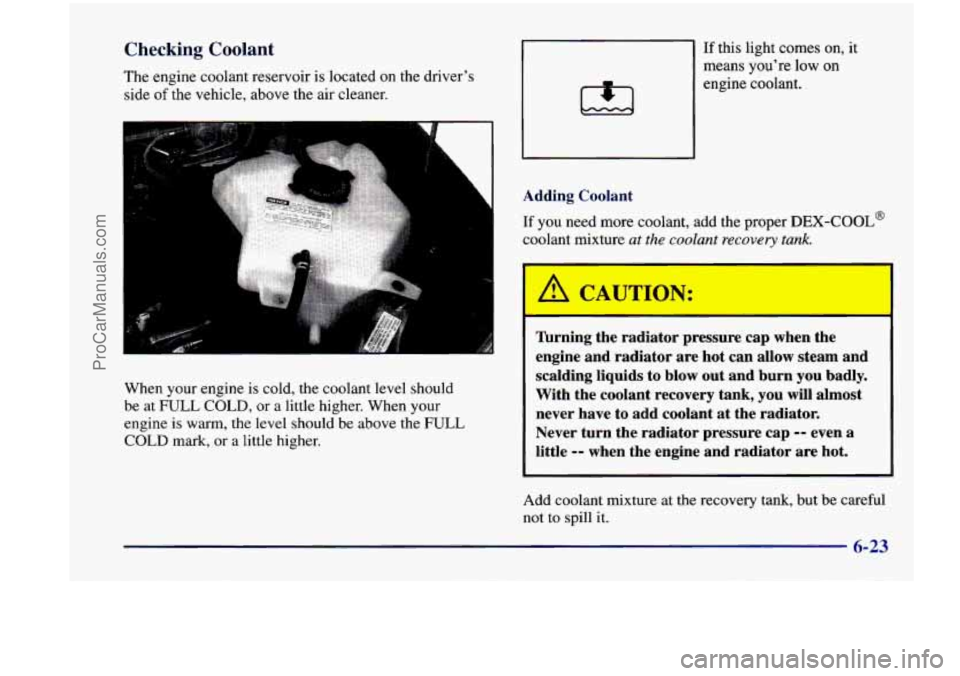
Checking Coolant If this light comes on, it
The engine coolant reservoir
is located on the driver’s
side
of the vehicle, above the air cleaner. means you’re low
on
engine coolant.
Adding Coolant
If you need more coolant, add the proper DEX-COOL@
coolant mixture
at the coolant recovery tank.
When your engine is cold, the coolant level should
be at FULL COLD, or a little higher. When your engine is warm, the level should
be above the FULL
COLD mark, or a little higher.
Add coolant mixture at the recovery tank, but be careful
not to spill it. ’hrning the radiator pressure cap
when the
engine and radiator
are hot can allow steam and
scalding liquids to blow out and burn you badly.
With the coolant recovery tank, you will almost
never have to add coolant
at the radiator.
Never turn the radiator pressure cap
-- even a
little -- when the engine and radiator are hot.
6-23
ProCarManuals.com
Page 359 of 474
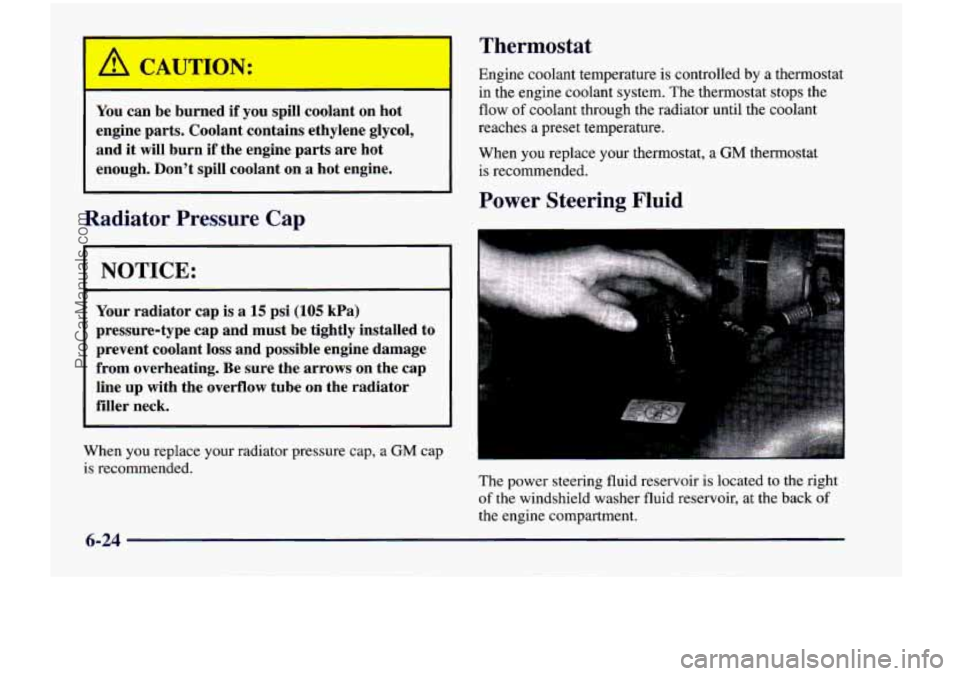
Thermostat
Engine coolant temperature is controlled by a thermostat
in the engine coolant system. The thermostat stops the
flow
of coolant through the radiator until the coolant
reaches a preset temperature.
You
can be burned if you spill coolant on hot
engine parts, Coolant contains ethylene glycol,
and
it will burn if the engine parts are hot
enough. Don't spill coolant on
a hot engine.
Radiator I ressure Cap
NOTICE:
Your radiator cap is a 15 psi (105 kPa)
pressure-type cap and must be tightly installed to
prevent coolant
loss and possible engine damage
from overheating. Be sure the arrows on the cap
line up with the overflow tube on the radiator
filler neck.
When you replace your radiator pressure cap,
a GM cap
is recommended. When you replace your thermostat, a
GM thermostat
is recommended.
Power
Steering Fluid
'l'kv Gower steering fluid reservoir is located to the right
of the windshield washer fluid reservoir, at the back of
the engine compartment.
ProCarManuals.com
Page 423 of 474
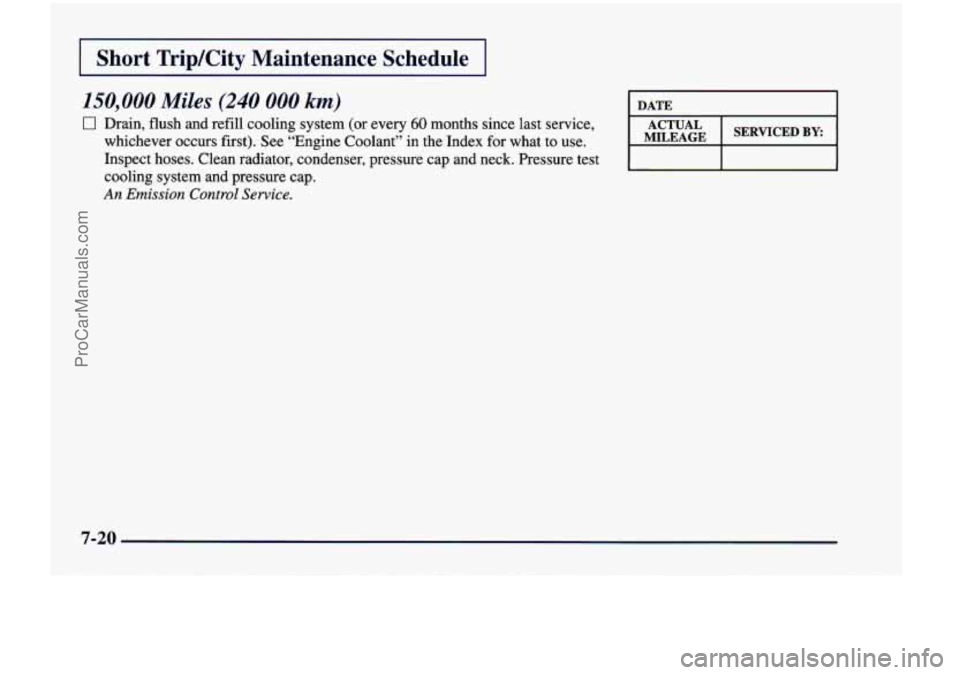
I Short Trip/City Maintenance Schedule I
150,000 Miles (240 000 km)
0 Drain, flush and refill cooling system (or every 60 months since last service,
whichever occurs first). See “Engine Coolant” in the Index for what to use.
Inspect hoses. Clean radiator, condenser, pressure cap and neck. Pressure test
cooling system and pressure cap.
An Emission Control Sewice.
MILEAGE ACTUAL I SERVICED BY:
7-20
ProCarManuals.com
Page 431 of 474

I Long Tripmfghway Maintenance Schedule I
100,000 Miles (166 000 km)
0 Inspect spark plug wires.
0 Replace spark plugs.
0 Change automatic transaxle fluid and filter if the vehicle is mainly driven
An Emission Control Service.
An Emission Control Service.
under one or more of these conditions:
- In heavy city traffic where the outside temperature regularly reaches 90°F
- In hilly or mountainous terrain.
(32°C) or higher.
- When doing frequent trailer towing.
- Uses such as found in taxi, police or delivery service.
If you do not use your vehicle under any of these conditions, the fluid and
filter
do not require changing.
150,000 Miles (240 000 km)
0 Drain, flush and refill cooling system (or every 60 months since last service,
whichever occurs first).
See “Engine Coolant” in the Index for what to use.
Inspect hoses. Clean radiator, condenser, pressure cap and neck. Pressure test
the cooling system and pressure cap.
An Emission Control Service.
DATE I
MILEAGE
I DATE I
I MILEAGE ACTUAL I SERVICEDBY I
7-28
ProCarManuals.com
Page 436 of 474
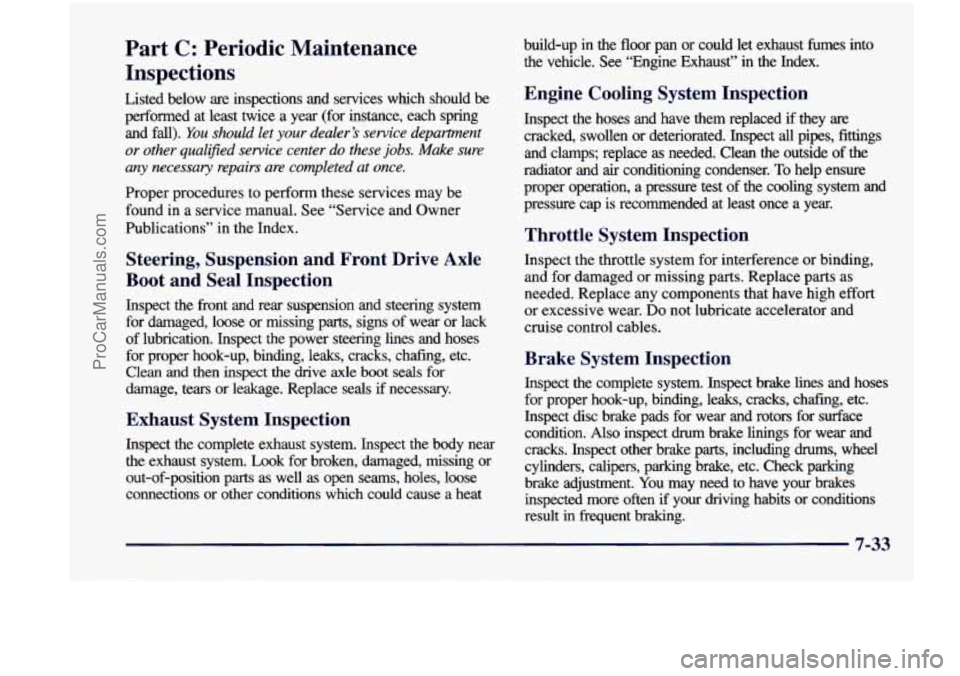
Part C: Periodic Maintenance
Inspections
Listed below are inspections and services which should be
performed at least twice a year (for instance, each spring
and fall).
You should let your dealer’s service department
or other qualijied service center do these jobs. Make sure
any necessary repairs are completed at once.
Proper procedures to perform these services may be
found in a service manual. See “Service and Owner
Publications” in the Index.
Steering, Suspension and Front Drive A: 3
Boot and Seal Inspection
Inspect the front and rear suspension and steering system
for damaged, loose or missing parts, signs
of wear or lack
of lubrication. Inspect the power steering lines and hoses
for proper hook-up, binding, leaks, cracks, chafing, etc.
Clean and then inspect the drive axle boot seals for
damage, tears or leakage. Replace seals if necessary.
Exhaust System Inspection
Inspect the complete exhaust system. Inspect the body near
the exhaust system.
Look for broken, damaged, missing or
out-of-position parts as well as
open seams, holes, loose
connections
or other conditions which could cause a heat build-up in the floor pan or could let exhaust fumes into
the vehicle. See “Engine Exhaust”
in the Index.
Engine Cooling System Inspection
Inspect the hoses and have them replaced if they are
cracked, swollen or deteriorated. Inspect
all pipes, fittings
and clamps; replace
as needed. Clean the outside of the
radiator and air conditioning condenser. To help ensure
proper operation, a pressure test
of the cooling system and
pressure cap is recommended at least once a year.
Throttle System Inspection
Inspect the throttle system for interference or binding,
and for damaged or missing parts. Replace parts as
needed. Replace
any components that have high effort
or excessive wear.
Do not lubricate accelerator and
cruise control cables.
Brake System Inspection
Inspect the complete system. Inspect brake lines and hoses
for proper hook-up, binding, leaks, cracks, chafing, etc.
Inspect disc brake pads for wear and rotors for surface
condition.
Also inspect drum brake linings for wear and
cracks. Inspect other brake parts, including
drums, wheel
cylinders, calipers, parking brake, etc. Check parking
brake adjustment. You may need to have your brakes
inspected more often if your driving habits or conditions
result in frequent braking.
- mm 7-53
ProCarManuals.com
Page 462 of 474

Front Seat Storage Net ........................... 2-71
Front Sidemarker Lamp Bulb Replacement
........... 6-36
Front Towing
.................................. 5-10
Fuel
.......................................... 6-3
Filling Your Tank
.............................. 6-5
Gage
....................................... 2-97
In Foreign Countries ........................... 6-5
Fuses and Circuit Breakers ....................... 6-58
Gages Engine Coolant Temperature
.................... 2-9 1
Fuel ....................................... 2-97
Speedometer
................................. 2-85
Garage Door Opener Compartment
................. 2-67
Gear Positions. Automatic Transaxle
................ 2-30
GloveBox
.................................... 2-66
Gross Axle Weight Rating
........................ 4-31
Gross Vehicle Weight Rating
...................... 4-30
Guide en Franpis
11
GAWR ....................................... 4-31
.. .................................
GVWR ....................................... 4-30
Halogen Bulbs
................................ 6-31
Hazard Warning Flashers
.......................... 5-2
Head Restraints
................................. 1-6
Headlamps
.................................... 2-60
Bulb Replacement ............................ 6-3 1
OnReminder ................................ 2-60
Wiring
..................................... 6-57
HighLow Beam Changer ...................... 2-54
Hearing Impaired. Customer Assistance
.............. 8-4 Heating
........................................ 3-4
High-BeamHeadlamps
.......................... 2-54
Highway Hypnosis
.............................. 4-24
Hill and Mountain Roads
......................... 4-24
Hitches. Trailer
................................. 4-36
Hood
Checking Things Under ......................... 6-8
Prop ........................................ 6-9
Release ...................................... 6-8
Horn ......................................... 2-52
Hydroplaning .................................. 4-20
Ignition Positions
.............................. 2-26
Ignition Transaxle Lock Check
.................... 7-32
Illuminated Entry
............................... 2-62
Inflation. Tire
.................................. 6-41
Inflator. Air
................................... 2-78
Inside Daymight Rearview Mirror
................. 2-65
Inspections
Brake System
................................ 7-33
Exhaust Systems
............................. 7-33
Front Drive Axle Boot ......................... 7-33
Front Drive Axle Seal
......................... 7-33
Radiator and Heater Hose
...................... 7-33
Steering
.................................... 7-33
Suspension
.................................. 7-33
Throttle
System .............................. 7-33
InstrumentPanel
............................... 2-82
Cleaning
.................................... 6-50
Cluster ..................................... 2-84
FuseBlock
.................................. 6-58
Light Intensity Control ......................... 2-61
ProCarManuals.com